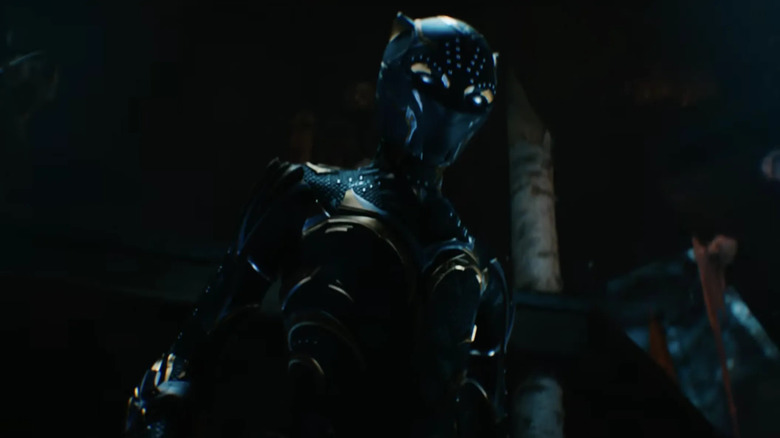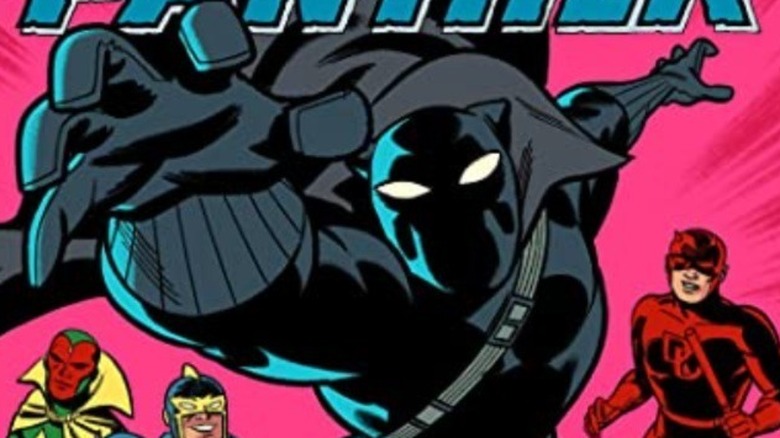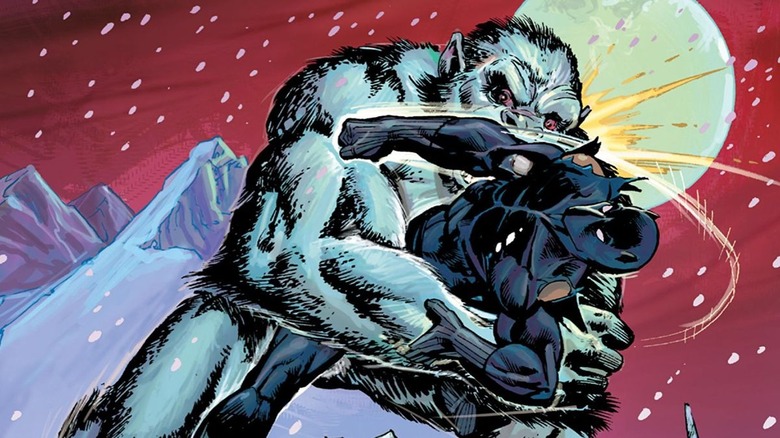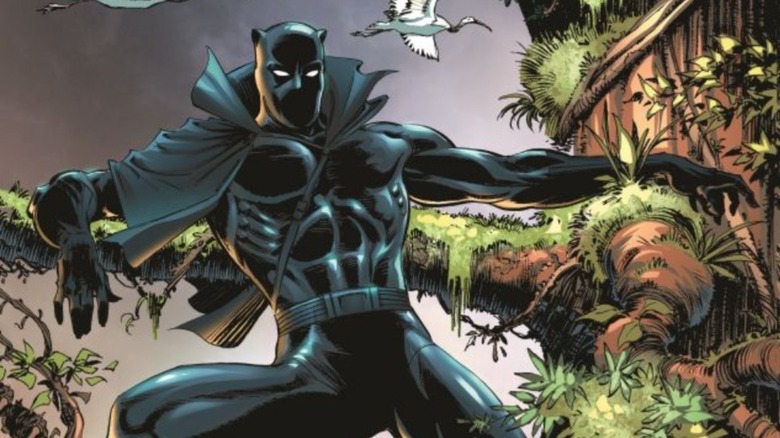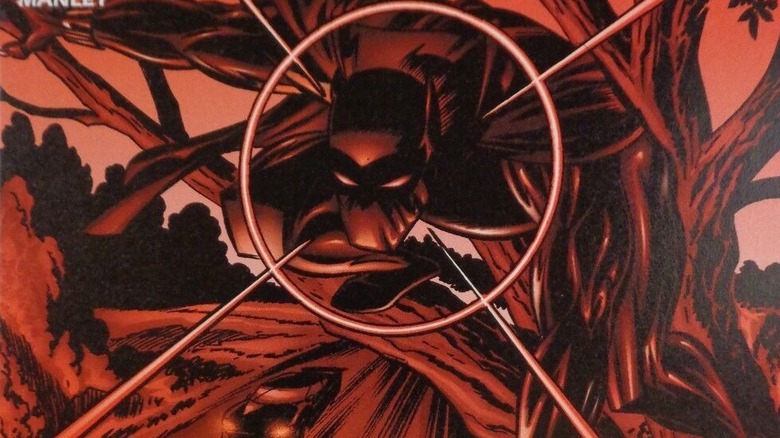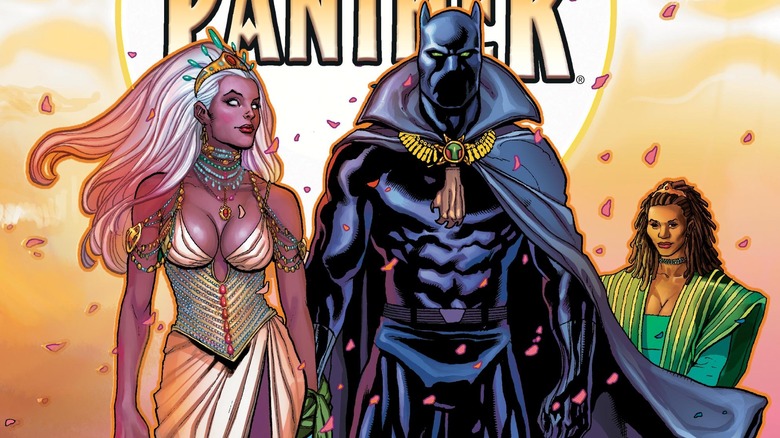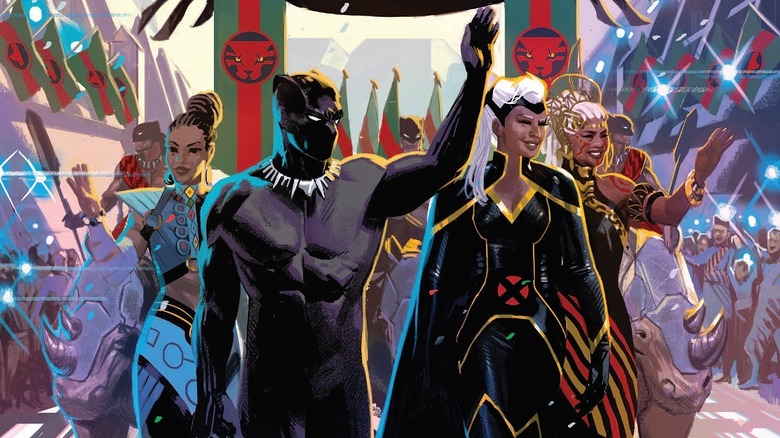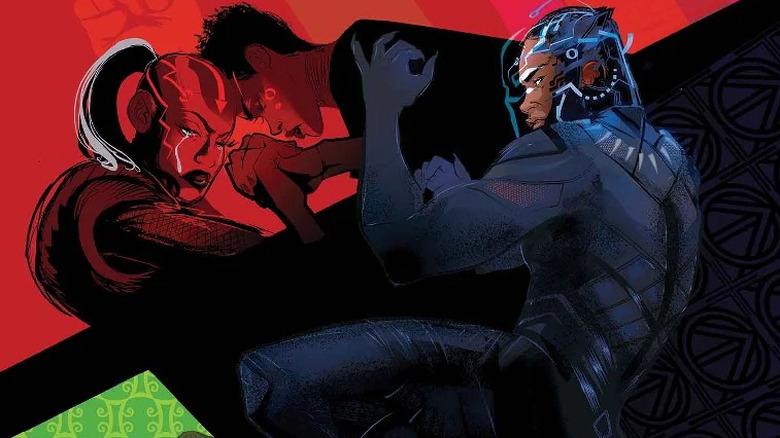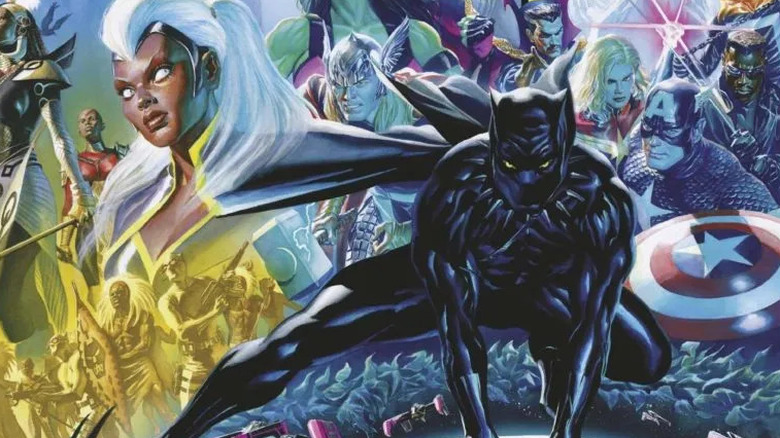18 Black Panther Comics You Need To Read
Comic book movies and comic books exist in an infinite reciprocation loop. Fans of Ryan Coogler's ecstatic "Black Panther" or epically mournful "Black Panther: Wakanda Forever" can turn to Marvel for more in-print stories. Marvel and its stable of A-list writing and illustration talent will continue spinning tales about T'Challa, Shuri, Namor, and more. With "Wakanda Forever" making more than $300 million worldwide in its first weekend of release, there is little chance this loop breaks anytime soon.
If the Marvel complex exhausts you, that status quo might be instantly tiring. Yet, the "Black Panther" comics canon is comprised of incredible offerings from some of the most compelling writers and thinkers of color from the 20th and 21st centuries. To deep dive, is to encounter the authors of "Between the World and Me" and "Bad Feminism." There are offerings from a Hollywood director and the first black writer-editor in mainstream comics. Engage with the "Black Panther" comics canon and you encounter Black history and excellence all at once in stories that thrill and provoke in equal measure. It is the antidote to superhero fatigue and cynicism. Here are the 15 Black Panther comics you need to read.
Fantastic Four #52 and #53 (1966)
Let's start at the very beginning.
I don't subscribe to the idea that you must read a comic book character's origin story. Some characters are so divorced from their initial introductions that returning to those roots is redundant. For example, DC Comics' Deadman is an incredibly compelling hero whose early ties to a Hindu god are both cringe and unnecessary.
While the Black Panther that readers and the Fantastic Four encounter in "Fantastic Four" #52 and #53 seems different than the one we've come to know and love, it's a relief that there is strong, shared DNA there, too. The Black Panther's first appearance finds T'Challa inviting Reed Richards, Sue and Johnny Storm, and Ben Grimm to Wakanda, only to attack them. This makes T'Challa look like a villain, but his true motives are quickly revealed. He's only battling the Fantastic Four to test his mettle and see if he's ready to fight Klaw, the sonic weapon-adorned arms dealer played by Andy Serkis in Ryan Coogler's film. It's a clever introduction that likely toyed with 1960s readers' expectations. Black Panther was introduced in the throws of the Civil Rights movement by co-creators Stan Lee and Jack Kirby. Both men understood that, to many bigoted whites in America, people of color were the enemy. Panther's introduction seems to confirm the racial biases of many but quickly pulls the rug out from under them. It sets a progressive tone that would be adopted for years to come.
Avengers #87 (1971)
Black Panther's ascension to becoming an active member of the Avengers is proof that Stan Lee, Jack Kirby, and Marvel were putting their full support behind the character. With "Avengers #87," that support went even further. It would be easy to save T'Challa's origin story for a future solo series, but by letting writer Roy Thomas and artist Sal Buscema reveal the history of the Black Panther within the pages of Marvel's flagship supergroup title, T'Challa and the nation of Wakanda became cemented in mainstream comic book lore.
Admittedly, "Avengers #87" is more of a historical footnote than the actual story, particularly since later tales by Jack Kirby, Don McGregor, and especially Christopher Priest would form the outline of the character audiences have come to know and love today. Since we're discussing must-read Black Panther comics, knowing T'Challa's true origins is essential. That gets "Avengers" #87 on the list.
Revenge of the Black Panther (1977)
The average comic reader likely knows Jack Kirby as an artist. The legend's broad, bruising pencil work transformed how superheroes look forever, merging real-world physicality with the fantastical. Kirby is also an author of some renown. With "Revenge of the Black Panther," readers see Kirby flex his muscles as both author and illustrator with a character he co-created.
"Revenge of the Black Panther" has everything. There are killer samurais, King Soloman's frog, and a three-way bout between the Avengers, Black Panther, and his foe Ulysses S. Klaw. Crucially, There's also a tremendous amount of Wakanda-altering world-building between the margins. Kirby continues to flesh out the character he first penned, serving up the origins of vibranium and placing him against apartheid, an issue rearing its head in South Africa during the 1970s. If Black Panther's debut found T'Challa becoming a post-civil rights icon, "Revenge of the Black Panther" plays into the heights afforded him by Blaxploitation. The story is bonkers to a degree not far from "That Man Bolt" or "Black Belt Jones" but is still deeply in touch with the issues of the time. Kirby establishes a balance for "Black Panther" stories that will be built on by Don McGregor with "Panther's Rage" and "Panther's Quest," so consider this a necessary first chapter in a character-shaping trilogy.
Panther's Rage — Jungle Action #6 through #8 (1972)
As a white writer, recommending a storyline featuring people of color ripped from the pages of a series called "Jungle Action" feels very suspect. Thankfully, "Panther's Rage" is worth the moniker mishap. The storyline, written by Don McGregor and drawn by Rich Buckler, is a massive expansion of Black Panther's worlds. He meets an A-tier foe for the first time. "Panther's Rage" is the debut of Erik Killmonger, who would go on to be the antagonist of Ryan Coogler's "Black Panther." Killmonger is arguably the most important villain in the "Black Panther" canon, which makes his introduction required reading.
The other reason to read "Panther's Rage" is that it crucially expands Wakanda. The main thrust of the story involves T'Challa attempting to save his country from Killmonger's terrorist whims, and that gives Rich Buckler opportunities to visually enrich Wakanda by leaps and bounds. The illustrative detail is lush and expansive. Yes, it's reductive by today's standards, but it opened the door for later artists and writers. Polygon detailed how "Panther's Rage" is considered one of the first graphic novels. It's a must-read because of what it does to advance Black Panther more than for its intrinsic excellence, but it isn't without its charms either.
Panther's Quest (1988)
Modern Marvel-literate audiences are familiar with T'Challa and his extended family since Ryan Coogler placed both at the heart of his "Black Panther" films. However, writer Don McGregor and artist Gene Colan cemented those essential relationships first.
"Panther's Quest" is a 25-chapter story published in "Marvel Comics Presents," an anthology that offered creators a chance to tell stories featuring lesser-known Marvel characters. Even though Black Panther took off during the late 1960s and through the heights of 1970s Blaxploitation, his star was dim relative to Spider-Man, the X-Men, and others. McGregor and Colan got to make him the A-story in the title for 25 issues, telling a sprawling tale of T'Challa's search for his mother that takes him to South Africa and the heart of the country's social injustice.
This strain of geopolitically focused storytelling is commonplace for "Black Panther" now, but only because of "Panther's Quest." McGregor and Colan redefined who T'Challa could be as a protagonist, finding complex emotional stakes in his familial relationships and placing Wakanda firmly in relationships with other real-life African nations. It's a bold approach to "Black Panther" storytelling that's a must-read for anyone who appreciates the modern interpretation of the character.
The Client (1998)
Where "Black Panther" is concerned, there's before Christoper Priest and after Christopher Priest.
Priest was the first black writer-editor at either of "the big two," a force of nature who radically altered the kinds of stories creators could tell about T'Challa. Take "The Client." It's the first "Black Panther" story arc for the Marvel Knights imprint, and it leans into all the adult themes and situations that the label allowed. The focus shifts from crime-fighting to international politics. The story, which concerns T'Challa traveling from Wakanda to New York to investigate a young girl's murder, introduces Dora Milaje and Everett Ross. (The framing device for the story is Ross escorting T'Challa cross-continent, offering Ross the chance to tell the Wakandan ruler how he almost sold his soul to Mephisto for a pair of pants — really.)
Priest also gives Wakanda a major status upgrade. The Marvel universe is full of fictional lands that vie for shares of world power. In "The Client." Priest makes Wakanda as big a player on the international scene as Atlantis or Latveria. That decision fundamentally changed the way Marvel Comics related to T'Challa. He is the leader of a nation as much (if not more) than he is a hero. That will shape the next two decades of "Black Panther" stories, making "The Client" a must-read if you care about modern T'Challa tales.
Enemy of The State (1998)
Christopher Priest's "Enemy of The State" arc feels like the inevitable conclusion of the "Black Panther" movies. That's a bold statement, but director Ryan Coogler and writer Christopher Priest share an affinity for bold political ideas. Killmonger dies, calling out the ever-present specter of colonialism. "Wakanda Forever" finds the world's governments so oppressive to the residents of Talokan and Wakanda that they fight each other. That's why "Enemy of The State" would be an ideal fit for Coogler's films.
Within its first few pages, T'Challa finds himself on the wrong end of a coup. Who has put the new ruler in play — and why — is the story's most intriguing plot thread. Suffice it to say the United States is involved, but the plot resolves both surprisingly and handsomely. Priest made a point of putting T'Challa on the world stage as a ruler of Wakanda. That makes the actions he takes different from a typical superhero. As Namor would later go on to stipulate in "Black Panther: Wakanda Forever," only the most broken people can be leaders. "Enemy of The State" explores that idea decades before Coogler's film by serving as a thoughtful character study of T'Challa and placing a genuinely broken villain on the throne in his stead.
Enemy of The State II (2002)
Sequels aren't just a Hollywood standard. They're plenty popular in modern comics, too. Marvel's "Civil War" crossover event got a blockbuster sequel. So did "Secret Wars" and DC's "Crisis on Infinite Earths." It should come as little surprise that Christopher Priest penned a self-contained follow-up to his blockbuster "Enemy of the State" arc, fittingly titled "Enemy of the State II." Like the best sequels, Priest's story expands the original's storytelling canvas and lets the plot be deadly serious and silly. Case in point: The cover of the first "Enemy of the State II" issue features Iron Man, Black Panther, and Wolverine mean-mugging readers from an oblique angle that would make MTV's "Total Request Live" proud.
What's sneakily subversive and thrilling about "Enemy of the State II" is how it inverts the stakes of the original. In that story, Wakanda was threatened by a coup. Here, the United States is under siege from within. The underrated villain XCon is attempting to steal the country from under President George W. Bush's nose (literally — Bush is recognizably drawn by artist Sal Velluto in the story's final chapter), and it takes Wakanda's help to stop it. This story would feel pointed whenever it was published. It came out one year after the events of September 11th. Christopher Priest was reading the tea leaves of where America might be headed, and "Enemy of the State II" is strangely prescient.
Killmonger's Rage (Black Panther #18, 2000)
"Killmonger's Rage" is arguably the most important modern "Black Panther" comic ever published. That's not because "Killmonger's Rage" is great. Although to be fair, it's excellent. It's because Eric Killmonger, played by Michael B. Jordan in the "Black Panther" films, has become a cultural icon. Killmonger is the modern template for thoughtful villainy, a mercenary whose screeds about institutionalized racism and setting society on fire are laced with uncomfortable truths. The genesis of that version of the character occurs in "Killmonger's Rage."
Throughout "Kilmonger's Rage," Killmonger is established as T'Challa's physical equal. Their fight is as knock-down and drag–out as it gets. The West is the defining difference between them. To the King of Wakanda, Killmonger is a man whose mind has been poisoned by American society. Time away from Wakanda has twisted his values. To Killmonger, though, this time away from Wakanda's relative paradise has shown him the truth of the worldwide experience for people of color. It's a radical reframing of Wakanda and T'Challa that doubles as a clever retcon of what makes Killmonger important. Few arcs have done as much for a character or a comic's mythology as this one, so "Killmonger's Rage" is a must-read if you care about Black Panther or his long-time foe.
A Story of Love and War (2001)
World leaders are human beings. They don't need to be humanized by the media or by content creators, and yet, the reminder that those in charge of society-shifting decisions are "just like us" always feels notable. Their motivations, like ours, aren't always clear or rational. Neither is love.
This is the core thesis of Christopher Priest's "A Story of Love and War," an arc that reunites Storm and Black Panther while thrusting Wakanda into a dangerous geo-political game with Latveria and Atlantis. When the story isn't retconning the history of Ororo and T'Challa as childhood lovers, it's deftly observing that Namor, Doctor Doom, and the Black Panther all run countries. Their decisions carry more than your typical street-level do-gooder or villain. The language of their heroism or evil is elevated. The war moves from cold to white-hot, eventually bringing Magneto and Genosha into the fold, and Black Panther's final battle with Klaw leads to T'Challa being put on trial.
That's a lot to sift through in just four issues. But Priest is clear-eyed in his aims. The title of the final "A Story of Love and War" installment is "A Continuation of Politics by Other Means." That issue contains bloody and expansive fighting. Love has led, through best intentions, to the battlefield, and all of it was politics. Sometimes the foibles of those in charge are impossible to understand. Here, they feel all too real — even for superheroes.
Who Is the Black Panther? (2006)
Filmmaker Reginald Hudlin took "Black Panther" to Hollywood. That shouldn't be surprising. The director-producer of "House Party" and "Boomerang" fame built his career on sweeping comedies that elevated their stars. "Boomerang" helped Eddie Murphy establish himself as a romantic comedy lead. "Marshall," starring "Black Panther's" Chadwick Boseman, cemented Boseman's penchant for playing larger-than-life figures. It's not surprising that Hudlin took a similar approach as T'Challa when he re-launched "Black Panther" in 2005. "Who is the Black Panther?" was Hudlin's first arc, and it's a delight. On the superhero side of things, Klaw is assembling a team of loveable B-list bad guys (Rhino! Batroc! Radioactive Man!) to attack T'Challa and Wakanda. The story's emotional beats find Hudlin reworking Black Panther's origin, framing him as a universally loved celebrity on the world stage. As if all this wasn't enough, there's the introduction of Shuri (who, it should be noted, is fighting to be Black Panther from the first moment audiences meet her, so it's no wonder she picked up the mantle on screen), and Black Panther meets the X-Men's Storm.
The final reason to recommend this volume is the art by comics legend John Romita Jr, who draws Black Panther with his signature dynamism. The artist's flare for gritty images lends Hudlin's flashy story a knockout visual gravitas that makes "Who is the Black Panther?" a feast for the eyes and mind and a must-read volume.
The Bride (2006)
From Peter Parker and Mary Jand Watson to the Scarlet Witch and Vision, superhero comics are full of star-crossed lovers and couples that survive impossible odds — until they don't. Black Panther and Storm are one such pairing, yet their time together is more profound and culturally resonant than it initially appears. Ororo and T'Challa are powerful people of color whose incredible gifts and standing in the world don't shield them from persecution. Yet, when the world that fears them is at war, they choose to try and unify it.
That's the primary thrust of "The Bride," a Reginald Hedland-penned arc that finds Ororo and T'challa's wedding functioning as a ceasefire for the events of "Civil War." Now made famous by the third "Captain America" movie, the massive Marvel event crossover pit hero against hero when the U.S. Government initiates the Super-human Registration Act. Given that those in support of the act favor increased authoritarianism, Storm and Black Panther's neutral wedding is particularly profound. Neither is a stranger to persecution by autocratic forces. "The Bride" is proof T'Challa can be as diplomatic as he can be heroic and as loving as he can be vengeful. It's a side of the character worth seeing, particularly given some of the arcs that follow.
See Wakanda and Die (2008)
Jason Aaron is a comic book master. He's an author whose frequently brutal stories marry pulp-fiction instincts to whatever character he tackles. It works more often than it doesn't, but it worked during his first go at "Black Panther" during the series' fourth volume.
"Secret Invasion" is a Marvel crossover epic that is about to regain its relevance. Earth 616 must defend itself from a shadowy Skrull invasion. In the primary series, that means massive battles and many heroes revealed to be secret Skrull villains. In Aaron's tie-in, "See Wakanda and Die" arc, it means defending Wakanda no matter what. What follows is closer to a war movie than a classic comic book story, and it's all the better for it.
"See Wakanda and Die" lacks the political intrigue and star-studded celebrity of Priest and Aaron's runs. It's mostly T'Challa and the army of Wakanda unleashed. Thankfully, that rules. Artist Jefe Palo lovingly renders both battles and the landscape of Wakanda in exquisite detail, making room for moments of joy and grotesque violence. Aaron, meanwhile, is wise enough to pen his story in a way that ties it into "Secret Invasion" but also lets it work as a stand-alone run.
A Nation Under Our Feet (2016)
"Wakanda forever." Those are the words that movie audiences most associate with "Black Panther." They are a call to arms and a cry for unity in the face of insurmountable odds. They become heartbreaking in Ta-Nehisi Coates' first "Black Panther" arc, "A Nation Under Our Feet."
Coates is arguably the most visible and potent Black social commentator in America today, a writer whose works are a successor to those of James Baldwin and Fredrick Douglass. It's little wonder his "Black Panther" stories tackle provocative themes with intelligence and no shortage of radical politics. In "A Nation Under Our Feet," Wakandans become possessed through the powers of supervillains Zenzi and Tetu. T'Challa swears to rid Wakanda of their evil, even if he must kill Wakandans in the name of peace. That causes others to rise against him in turn.
Wisely, Coates identifies the tension between Black Panther's role as a fighter and his role as a leader. It looks at the trickle-down effect of poor leadership, which is even more resonant in the wake of the January 6th insurrection. It works as a thrilling comic book story, even as it tackles these heady ideas. In other words, it's peak Ta-Nehisi Coates and Black Panther all in one.
The Intergalactic Empire of Wakanda (2017)
If "A Nation Under Our Feet" finds T'Challa reckoning with his and Wakanda's identities, "The Intergalactic Empire of Wakanda" finds both tackling the myth that made them. Legend has it that a meteorite blessed Wakanda with vibranium. In the wake of his country's civil war, T'Challa becomes determined to find the source of that meteorite. That means heading to space.
Yes, "Black Panther in space" is just as fun as it sounds — up to a point. What Black Panther finds along the way is too good to spoil, but suffice it to say that the source of the vibranium mirrors Wakanda itself in ways both wonderful and wicked. Coates' approach is unbelievably brave, folding a space opera into larger questions of what bearing the history of Black people on Earth has on the universal experience of Black people beyond our galaxy. It's wild, heady stuff that goes far beyond your average "Big Two" superhero comic. It's a must-read for Black Panther or comic book fans, period.
Dawn of the Midnight Angels (2016)
Not every must-read "Black Panther" comic is about the Black Panther. The "World of Wakanda" series, which debuted during Ta-Nehisi Coates' "Black Panther" run, is thrilling proof of this. The series offered creators a direct line to fleshing out Wakanda's supporting players. In "Dawn of The Midnight Angels," that means Ayo and Aneka.
Ayo and Aneka got the short shrift in "Black Panther: Wakanda Forever," an excellent movie overstuffed with characters. "Dawn of the Midnight Angels" gives them the story they deserve. Roxanne Gay crafts a complicated tale of how Ayo and Aneka's feelings for one another reveal themselves through training to be part of the Dora Milaje, expertly drawing parallels to queer experiences in military culture and telling a genuinely compelling tale of young love. The story is also an excellent look into the history of the Midnight Angels. Fans of "Wakanda Forever" owe themselves a look at "Dawn of the Midnight Angels" if they enjoyed that film's third-act battle.
The Long Shadow (2021)
The "Black Panther" comics have drawn an incredible array of Black writing talent into their fold. While following Ta-Nehisi Coates is no small order, John Ridley ("12 Years a Slave," "American Crime") proved up to the task. Ridley's background is more superhero-ready than it appears at first glance. "Those Who Walk in Darkness," a novel he wrote in 2003, is about a task force that eliminates superpowered persons in a futuristic Los Angeles, and he cashed in his accolades to tell a breakneck action story with "The Long Shadow."
Ostensibly a spy thriller by way of the Black Panther, "The Long Shadow" finds T'Challa and Shuri in pursuit of a master assassin. Juann Cabal and Stefano Landini's art shines throughout the early action sequences, and the dynamic writing calls to mind John Le Carre. As the story evolves, Ridley whips together an evisceration of undying loyalty and the dangers of putting one's country before its people. This is as modern and forward-thinking as "Black Panther" stories get, and that pushes it into must-read territory.
The Thin Line Between Peace and Violence (2022)
Yes, I'm recommending a comic that's currently being published by co-signing "Black Panther" #11, "The Thin Line Between Peace and Violence." The story could wind up a dud, no question. That said, it's vital to read current iterations of characters so that one's perception of them never gets stale or misty-eyed. "The Thin Line Between Peace and Violence," which continues the story John Ridley began in "The Long Shadow," pushes T'Challa into new and dangerous narratives.
For one, the events of "The Long Shadow" have transformed Wakanda from a monarchy to a democracy. That begs the question of who T'Challa is when he's no longer a King, and "The Thin Line Between Peace and Violence" doesn't offer easy answers. What's more, the reveal of who has been pulling T'Challa's strings since "The Long Shadow" offers dizzying possibilities for the character's future. "The Thin Line Between Peace and Violence" is a strong suggestion that as good as the history of "Black Panther" comics has been, the brightest days for T'Challa stories may still be yet to come.
